Key takeaways:
- Multigenerational workplaces combine diverse perspectives that can enhance innovation and creativity while also presenting challenges in communication and work styles.
- Diversity fosters a sense of belonging and empowers individuals, leading to improved morale and performance within teams.
- Effective collaboration across generations requires empathy, open dialogue, and the acknowledgment of different communication styles to bridge gaps and leverage collective strengths.
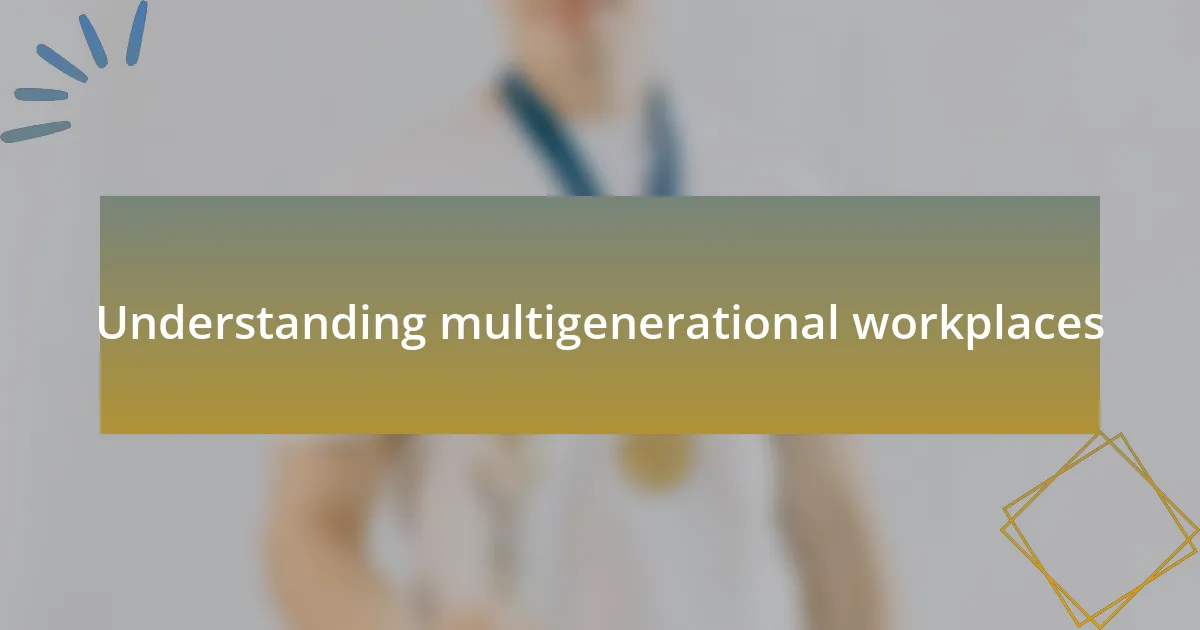
Understanding multigenerational workplaces
Multigenerational workplaces consist of employees from various age groups, typically including Baby Boomers, Generation X, Millennials, and Generation Z. Just the other day, I overheard a conversation between a seasoned professional and a young intern, which sparked my curiosity. The intern’s fresh perspective on digital marketing seemed to energize the older colleague, who shared insights from decades of industry experience. How fascinating is it that such a blend of viewpoints can create a dynamic and innovative work environment?
In my experience, navigating a multigenerational team can bring both challenges and rewards. Sometimes, the varying work styles and expectations lead to misunderstandings. I remember a time when a younger coworker suggested a rapid approach to a project that clashed with a more traditional method embraced by others. It raised an interesting question: How can we find common ground and learn from each other’s strengths?
Embracing multigenerational collaboration requires empathy and openness. Consider how each generation approaches problem-solving, learning, and communication differently. I often reflect on how my own perspectives have evolved from collaborating with colleagues of different ages. It’s a reminder that, despite our differences, we can teach and inspire one another to achieve greater outcomes in our work lives.
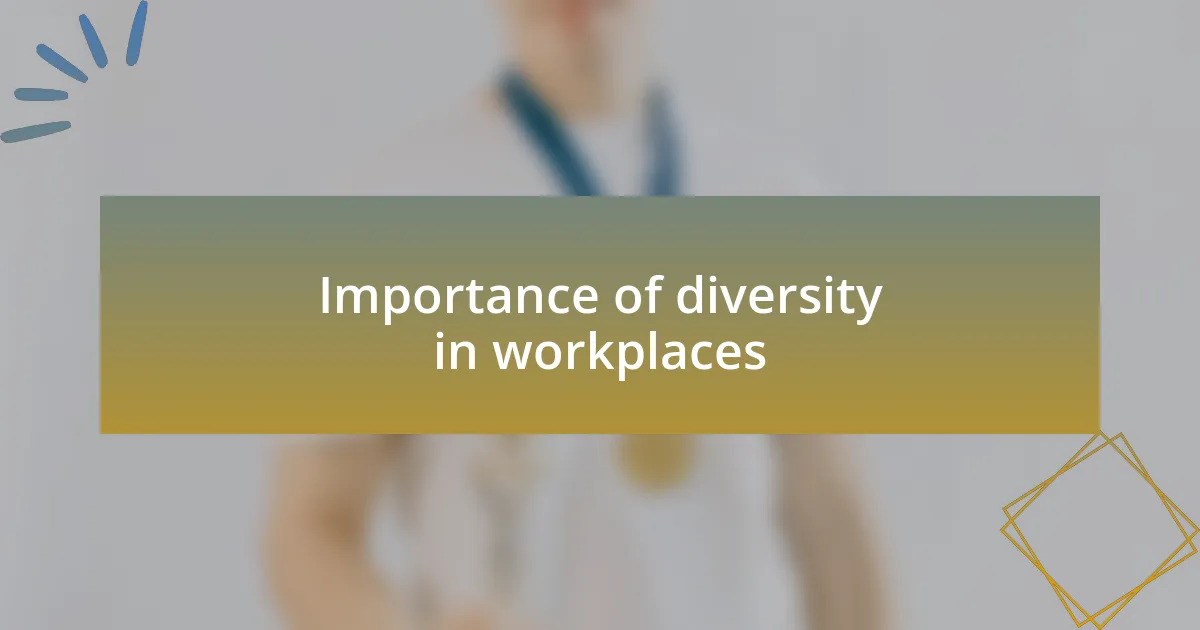
Importance of diversity in workplaces
Diversity in workplaces isn’t just beneficial; it’s essential for driving innovation and creativity. I distinctly remember working on a project where our team was a mix of ages and backgrounds. The variety sparked debates that challenged our assumptions and led to a breakthrough idea, which would have likely gone unnoticed in a more homogenous group. Have you ever considered how diverse perspectives can illuminate blind spots we didn’t even know we had?
Moreover, having a diverse team fosters a sense of belonging among employees. When individuals see themselves represented within the workplace, it not only boosts morale but also enhances performance. I once attended a company seminar where an employee shared how feeling valued for her unique experiences paved the way for her career advancement. Isn’t it inspiring to realize that fostering diversity can empower individuals while driving the entire company forward?
Additionally, embracing different viewpoints prepares organizations to better engage with a global market. I recall a brainstorming session where a colleague from a different cultural background proposed a marketing strategy that resonated with a broader audience. It made me think: How can we better connect with customers if we only think from our own limited perspectives? This experience solidified my belief that our differences should not be seen as barriers but rather as our greatest assets.
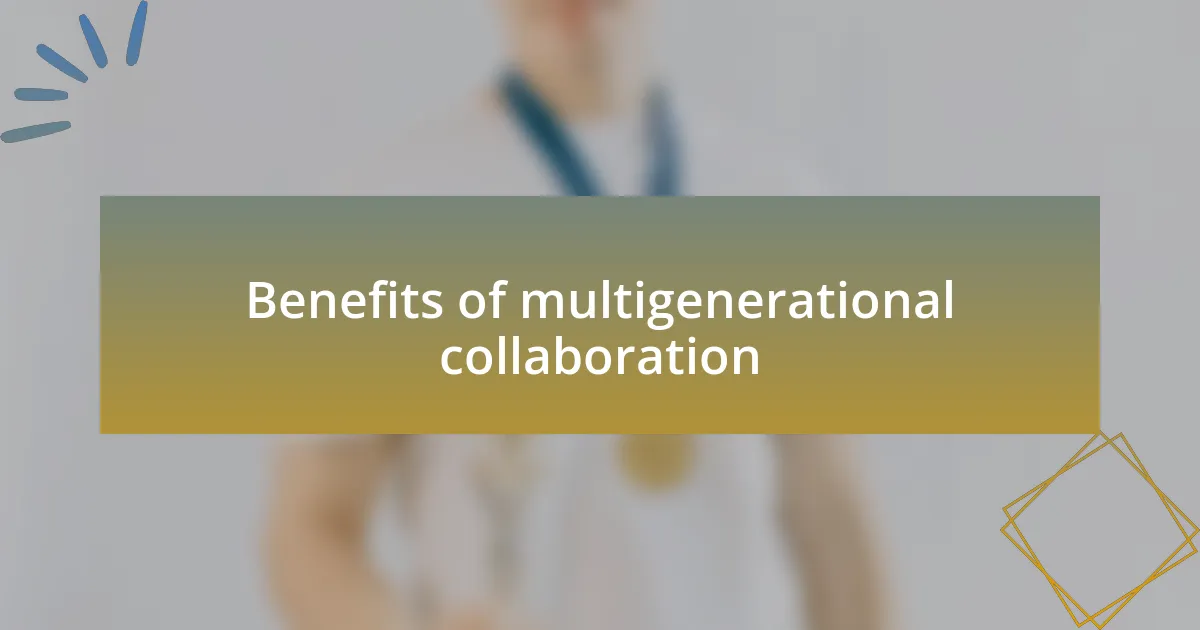
Benefits of multigenerational collaboration
Leveraging a multigenerational workforce brings together a wealth of experience and fresh ideas. I remember collaborating with a younger colleague who introduced me to social media strategies I hadn’t considered before. This exchange not only enhanced our outreach efforts but also reminded me that learning can truly go both ways. Isn’t it exciting how various age groups can blend their skills to create something innovative?
In my previous role, I noticed how older employees excelled in mentorship, guiding younger staff through the intricacies of the industry. Their stories often revealed lessons that textbooks missed. It makes me reflect: what if we actively encouraged those exchanges? The result can be a dynamic culture where learning and growth are continuous, leading to improved team cohesion and productivity.
Moreover, multigenerational collaboration encourages adaptability. During a team pivot in response to a new challenge, I witnessed colleagues from different age groups come together, each contributing their unique perspectives to develop a robust solution. Seeing this firsthand reinforced my belief that age diversity equips teams to approach problems from multiple angles. Have you ever faced a challenge where insights from various generations provided the breakthrough you needed? It truly showcases the power of collective wisdom.
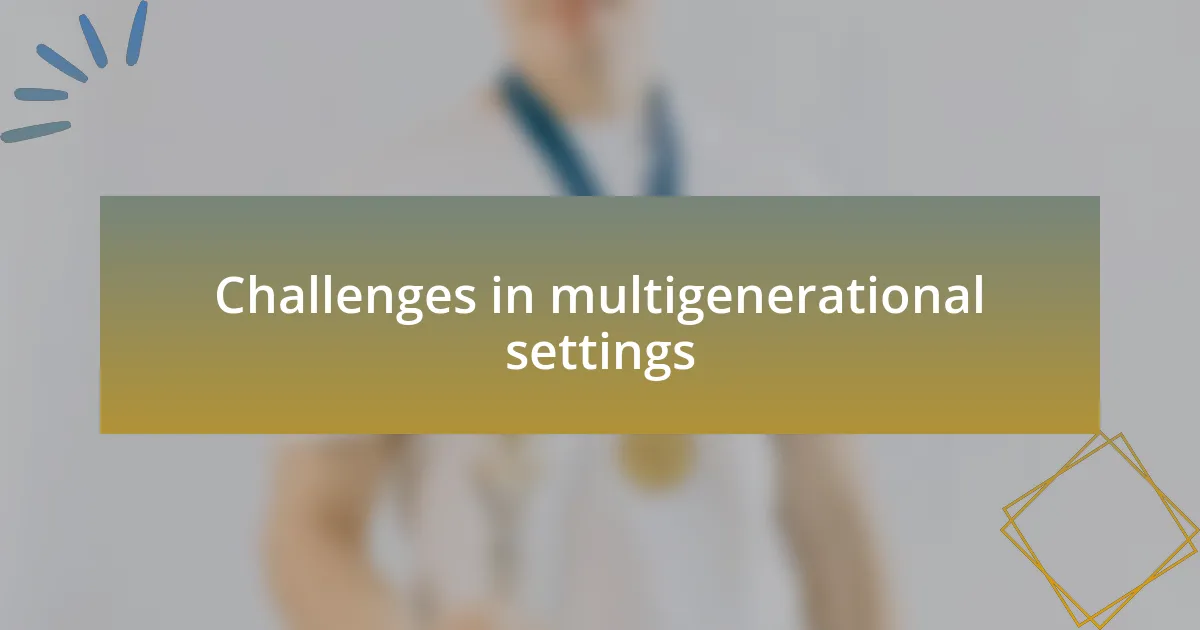
Challenges in multigenerational settings
Navigating a multigenerational workplace often brings unique challenges that can sometimes feel daunting. For instance, I once observed a communication clash between a seasoned employee and a younger one during a project meeting. The older staff member relied heavily on traditional methods, while the younger colleague preferred quick, digital communication. That situation made me ponder: how can we bridge these gaps to foster better understanding and collaboration?
Another challenge I faced involved differing work ethics and expectations. A younger team member once expressed frustration at the pace the older employees set, while those seasoned professionals felt that the newcomers weren’t putting in enough effort. This tension made me realize that fostering an environment of mutual respect and open dialogue is essential. How can we encourage a culture that values both experience and the eagerness to innovate?
Moreover, I’ve noticed that tech adaptation can be a barrier. During a training session, I witnessed some team members struggle with new software, which affected our productivity. It was a powerful reminder that patience and inclusive training methods are crucial in helping everyone feel competent and confident. Have you experienced a similar moment when the learning curve felt frustrating? It highlights the importance of accommodating diverse learning styles to ensure we all move forward together.
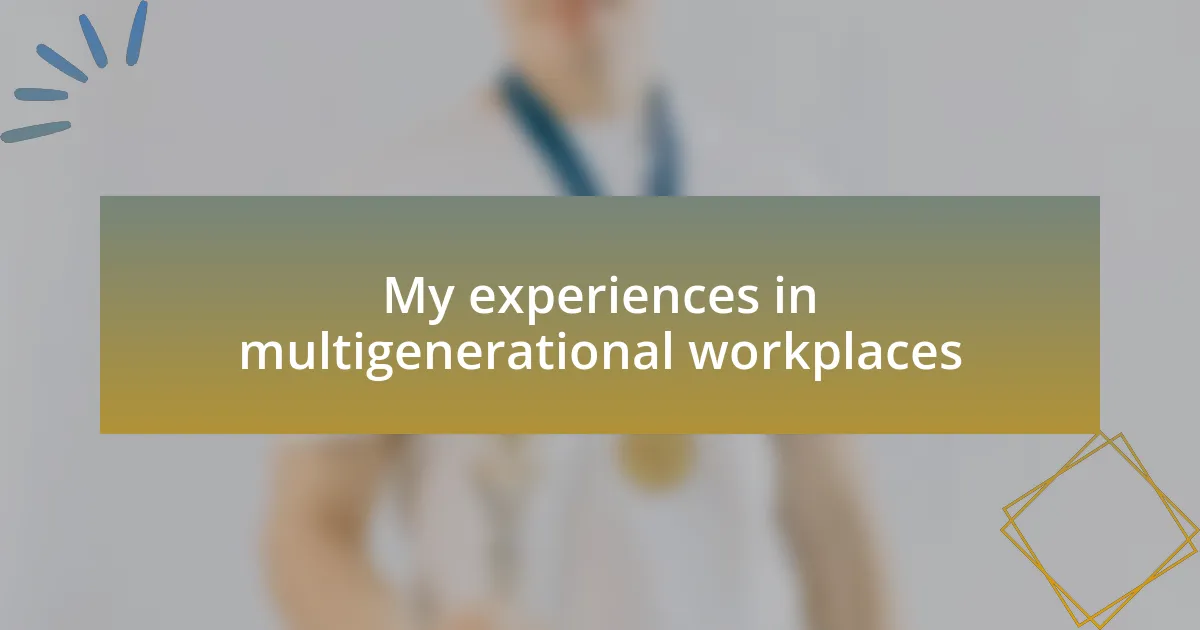
My experiences in multigenerational workplaces
In my experience, working alongside different generations can be incredibly rewarding, though it often feels like walking a tightrope. I remember collaborating on a project where the playful banter between an older mentor and a fresh college graduate led to unexpected creative solutions. Their contrasting perspectives not only sparked innovation but also made the workplace feel like a vibrant melting pot of ideas. Isn’t it fascinating how diverse backgrounds can create a rich tapestry of collaboration?
I’ve also sensed a palpable shift in collaboration dynamics when diverse age groups come together. There was a moment during a brainstorming session where a junior employee suggested the unthinkable—something that completely deviated from our established norms. Initially, I felt a wave of skepticism wash over me, but seeing how it energized the room made me rethink my own hesitations. Isn’t it refreshing when new ideas challenge the status quo and push us out of our comfort zones?
Yet, I can’t ignore the moments that felt divided rather than unified. After a team outing meant to foster bonding, I noticed some older colleagues still clinging to their familiar traditions while younger members sought new experiences. That division evoked a sense of nostalgia mixed with concern in me—how can we bridge those divergent paths to truly connect? These experiences continually teach me that understanding and empathy are key ingredients in forming a cohesive team capable of transcending age differences.
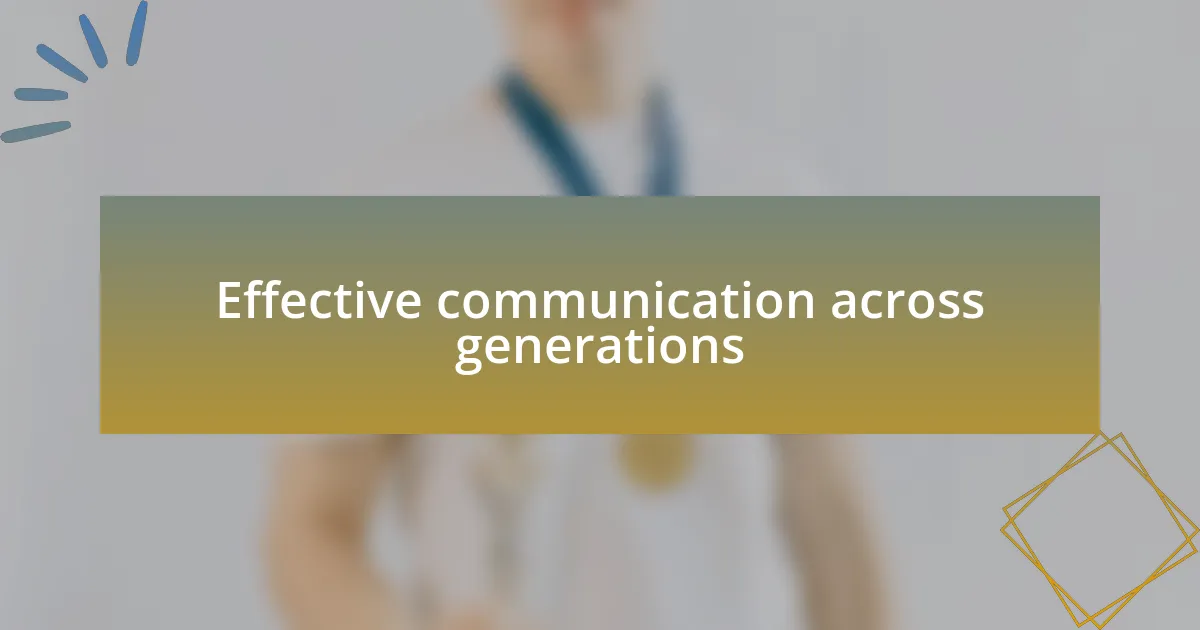
Effective communication across generations
Effective communication across generations often hinges on understanding different communication styles. For instance, I once noticed how a seasoned colleague preferred face-to-face meetings, feeling they fostered stronger connections. On the other hand, younger team members leaned towards instant messaging, valuing speed and convenience. This contrast made me realize that both methods have their merits, but a blend of them can create a more inclusive environment.
There was a time when an intergenerational team I was part of struggled with feedback. The older members offered lessons drawn from their long careers, yet some younger colleagues found this too directive. I stepped in to encourage a more dialogic approach where everyone could share their thoughts openly. It was rewarding to see how that simple shift allowed for richer discussions—doesn’t it make you wonder how adjustments in communication can lead to better connections?
Sometimes, I’ve felt the weight of silence during conversations when generational gaps felt especially wide. At one team meeting, I noticed how a Gen Z employee hesitated to voice their ideas among veteran staff. Recognizing this, I gently encouraged them, highlighting that every perspective was valuable. The spark in their eyes when they shared their thoughts reminded me that when we create safe spaces for dialogue, we unlock potential from all ages. What if we could harness this potential more often?